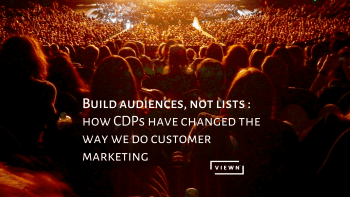Do you remember when creating a target audience was the only way to compile a list of email addresses? Well, those days are long gone! Customer data platforms (CDPs) have revolutionized the way we do customer marketing. You can build target audiences in real-time based on your customers’ interactions with your brand. This means that you can create highly personalized messages that are more likely to result in sales. CDPs allow you to get insights about your customers from the data within your business. So, if you want to generate more revenue for your business, it’s time to start using a CDP for target audiences!

Target audiences
Who do you want to reach out to? The target audience is who you’re trying to get in touch with. Your potential clients, for example. The group of people you wish to market your products or services to. It may be characterized by behavioral and demographic information such as age, gender, income, education level, or location. If you utilize audience groups.
Finding the correct audience might be critical to the success of your campaigns. McKinsey’s research says tailored advertising that meets clients’ demands can significantly boost ROI – up to 8 times and sales by at least 10%.
When we specify our target audience and learn how we can assist them in acquiring improved outcomes, that’s important. Now, let’s investigate the diverse kinds of audiences that exist. Targeted audiences, by definition, are more segmented customers; now, there are new techniques to learn about the different customer segments and personas. According to Yahoo’s research, personalized advertisements are more engaging for 54% of consumers
Demographics
As table stakes, you can define a target audience from your data by demographics, but this often depends on whether they provided you with that demographic data. You will need a personal email or home address to get audience profiles related to income and household characteristics and tie them to outside data sources for augmentation.
Socioeconomic data revolves around a user’s attributes, such as age, income, education, gender, or geographic location. By using demographic data points, you can target your campaigns more effectively. For example, you could show ads to 30-55-year-olds who live in population-dense areas (larger than 20k).
Interests
Brands often start because, for some reason, the product and customer experience aligns with an interest or priority. This section is about what people like to do, what interests them, and what they’re looking for or reading about. It might be anything from books to movies, music to automobiles, marketing to parenting. You may use this data in a variety of ways. For example, you could give a new book to readers or a new album from their favorite musical band. The technology behind that is a recommendation engine or a CDP.
We’ve tried to tie interests to product categories, but the best way to understand interests and the next section, Purchase intentions, is to ask the customer. Find out if they are buying for themselves for a parent. Find out if they what they need in a subscription or what it would take for them to purchase again. With new technology and techniques in machine learning and AI, there are ways to request feedback from annoying your customers or having to bribe them with discounts. Our trusted partner, CEO Analytics, has some money-making use cases with real results.
Purchase intentions
This data is crucial for e-commerce retailers as it can help you understand what groups of users are interested in specific products. For example, if you have a group of users who have recently looked for laptops but haven’t purchased one yet, this could indicate they need more information before making a purchase. Other audience types in this category include women’s clothing, skiing gear, televisions, tablets, and vehicles. There are people in the industry that just know. Most look at adjacent product categories. People are predictable. You just need to measure and ensure you have it right. You most likely will uncover other personas that you can target.
These are just four ways to target audiences. Look at your existing data of insights. If you can’t find customer insights, you better build some. Investigate the data in your CDP and set up real-time target audiences. The list work is one and done. CDPs work for you 24/7. Take into consideration previous behaviors, time, and geography. The content you write to sell products works because it is more specific. Customer marketing has changed for the better with CDPs. What are your thoughts on the role of CDPs in creating targeted audiences? Have you started using one for your business? Let us know in the comments below!



